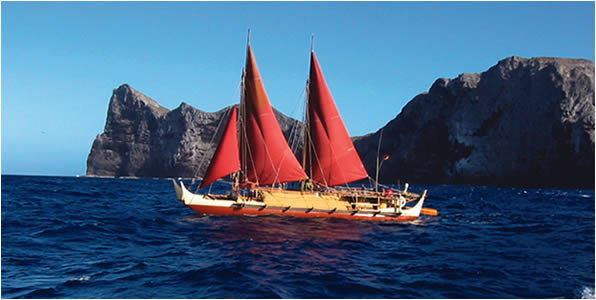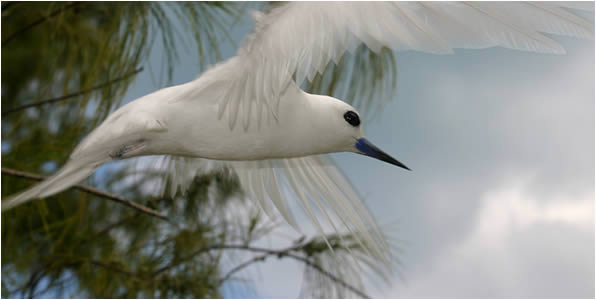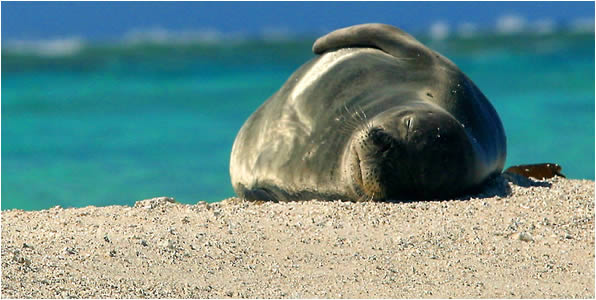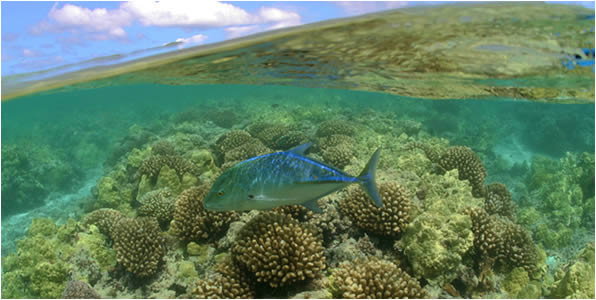Papahānaumokuākea Marine National Monument becomes first mixed UNESCO World Heritage Site in the U.S.
July 30, 2010
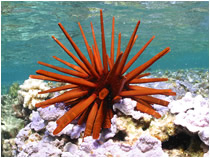 On July 30, 2010, delegates to the United Nations Educational, Scientific and Cultural Organization’s (UNESCO) 34th World Heritage Convention in Brasilia, Brazil, agreed to inscribe Papahānaumokuākea Marine National Monument as one of only 28 mixed (natural and cultural) World Heritage Sites in the World at that time. Globally, Papahānaumokuākea is also one of only 50 marine sites. Inscription of this remote oceanic expanse was a win for the United States on its first nomination of a site in 15 years. The vote also establishes the first mixed World Heritage Site in the nation, which covers an area of nearly 140,000 square miles. Download the official decision on the Papahānaumokuākea Inscription (1.4mb pdf). For more information, please visit the UNESCO website.
On July 30, 2010, delegates to the United Nations Educational, Scientific and Cultural Organization’s (UNESCO) 34th World Heritage Convention in Brasilia, Brazil, agreed to inscribe Papahānaumokuākea Marine National Monument as one of only 28 mixed (natural and cultural) World Heritage Sites in the World at that time. Globally, Papahānaumokuākea is also one of only 50 marine sites. Inscription of this remote oceanic expanse was a win for the United States on its first nomination of a site in 15 years. The vote also establishes the first mixed World Heritage Site in the nation, which covers an area of nearly 140,000 square miles. Download the official decision on the Papahānaumokuākea Inscription (1.4mb pdf). For more information, please visit the UNESCO website.
Those engaged in the process at that time had these comments to make about the inscription:
“Inscription confirms what we feel in our hearts every day,” said Susan White, former U.S. Fish and Wildlife Superintendent for the Monument. “We thank the UNESCO delegates for their recognition that Papahānaumokuākea is a profoundly wonderful place for wildlife, for our host culture, and now for humanity. As a nation, we’ve solidified our promise to the world that we will continue to protect it.”
Where Nature and Culture Are OnePapahānaumokuākea’s globally significant natural attributes incorporate its living, indigenous, cultural connections to the sea––where modern Hawaiian wayfinders (non-instrument navigators) still voyage for navigational training on traditional double-hulled sailing canoes; an aspect of inscription unique to Papahānaumokuākea. Additionally, World Heritage status places this traditional skill, which was used to navigate across the world’s largest ocean––one of the greatest feats of human kind––onto the world stage.
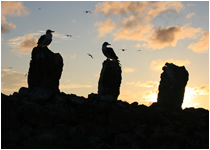 “This inscription, a first natural and cultural inscription for Hawai‘i, and a first inscription in 15 years for the United States, elevates Hawai‘i in the eyes of the world and underscores our responsibility to protect our culturally, naturally and spiritually significant places for future generations, as our ancestors would want,” said Haunani Apoliona, former Chairperson of the Office of Hawaiian Affairs Board of Trustees.
“This inscription, a first natural and cultural inscription for Hawai‘i, and a first inscription in 15 years for the United States, elevates Hawai‘i in the eyes of the world and underscores our responsibility to protect our culturally, naturally and spiritually significant places for future generations, as our ancestors would want,” said Haunani Apoliona, former Chairperson of the Office of Hawaiian Affairs Board of Trustees.
‘Aulani Wilhelm, former NOAA Superintendent for the Monument agreed. “We hope Papahānaumokuākea’s inscription will help expand the global view of culture and the contributions of Oceanic peoples to World Heritage and underscore that for so many indigenous peoples, nature and culture are one,” Wilhelm said.
Hawai‘i’s Second World Heritage SitePapahānaumokuākea is the second World Heritage Site in the State; Hawai‘i Volcanoes National Park was inscribed in 1987. Together, the two sites emphasize one of the six criteria for which the Monument was designated. The small islands, reefs, and shoals of Papahānaumokuākea represent the longest, clearest, and oldest example of island formation and atoll evolution in the world, spanning 28 million years, which contrasts strikingly with Hawai‘i Island’s continued volcanic growth at the southeastern end of the Hawaiian Archipelago.
‘Āina Momona - Place of AbundanceThe near pristine remote reefs, islands, and waters of Papahānaumokuākea provide refuge and habitat for a wide array of threatened and endangered species and is one of the last predator-dominated coral reef ecosystems on the planet; manō (sharks) and ‘ulua (jacks) dominate the underwater landscape. The region also provides critical nesting and foraging grounds for 14 million seabirds making it the largest tropical seabird rookery in the world.
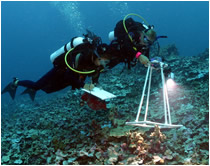 Management and Visitation
Management and Visitation
World Heritage designation does not change the Monument’s cooperative federal-state management mission, plan or structure, nor does it impose, change or add regulations or restrictions. The Monument’s management philosophy and regulations have always been designed to “bring the place to the people” through education, virtual exposure, and extremely limited visitation. Although inscription has increased tourism at other World Heritage sites, for Papahānaumokuākea, the situation is quite different. All human access and activity will remain by permit only, with visitation by the public restricted to Midway Atoll under strict carrying-capacity guidelines.
Sharing Papahānaumokuākea with the WorldLaura Thielen, Chairperson of the Hawai‘i Department of Land and Natural Resources, summarized: “World Heritage inscription for Papahānaumokuākea allows us to share her stories, obtain global recognition of Hawai‘i’s special attributes, and bring the place to our residents, visitors and to people around the world.” Papahānaumokuākea is cooperatively managed to ensure ecological integrity and achieve strong, long-term protection and perpetuation of Northwestern Hawaiian Island ecosystems, Native Hawaiian culture, and heritage resources for current and future generations. Four co-trustees – the Department of Commerce, Department of the Interior, the State of Hawai‘i, and the Office of Hawaiian Affairs, protect this special place.
![]()
Information from the U.S. Nomination of Papahānaumokuākea
Marine National Monument for World Heritage Inscription,
January 2009
